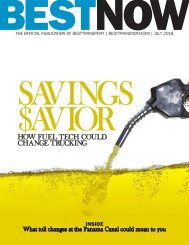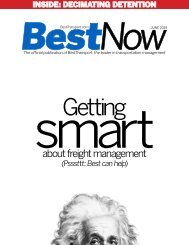You also want an ePaper? Increase the reach of your titles
YUMPU automatically turns print PDFs into web optimized ePapers that Google loves.
BestNow<br />
The official publication of BestTransport, the leader in transportation management<br />
BestTransport.com<br />
OCTOBER 2018<br />
OLL ON<br />
As carriers battle through<br />
the driver shortage, a<br />
look at how shippers can<br />
minimize the impact.
PORT OF ENTRY ASK REO<br />
Electric<br />
avenue<br />
C<br />
alifornia is home to almost<br />
half the nation’s<br />
electric vehicles and<br />
its own winding road of<br />
Catch-22s. The facts connect.<br />
The Golden State taxes fuel<br />
heavily, generating revenue<br />
upon which it depends to maintain<br />
a massive infrastructure,<br />
including a vast road network<br />
totaling nearly 400,000 miles.<br />
The heavy taxes are intended<br />
partly to discourage reliance<br />
on petroleum, which pollutes,<br />
and the intent is being fulfilled,<br />
driving motorists to electric<br />
cars in droves. That has driven<br />
down fuel tax revenues, leaving<br />
California short on money for<br />
highway upkeep.<br />
That’s why state lawmakers<br />
decided last year to impose a<br />
fee on plug-in cars. They also<br />
launched a study into taxing<br />
2 best now<br />
motorists by miles driven, based<br />
off odometer readings. All this<br />
proves a point that BestTransport<br />
Chief Operating Executive<br />
J. ScOTT Cummans<br />
President and CEO<br />
Reo B. Hatfield<br />
Chief Operating Executive<br />
Reo B. Hatfield makes in the<br />
latest edition of Ask Reo:<br />
Scott Cummans, CEO,<br />
Best: “Reo, the question I have<br />
is about these new electric<br />
trucks. Won’t they reduce our<br />
fuel surcharge to zero?”<br />
Reo B. Hatfield: Scott, I<br />
have the Paul Harvey response.<br />
The rest of the story, as he<br />
called it, is interesting:<br />
“Electric cars and trucks are<br />
a good idea. We all have our<br />
thoughts on pollution, fuel cost<br />
and its impact. It is thought that<br />
electric- (battery-) operated<br />
trucks would really save money<br />
for drivers and carriers, but<br />
what is the rest of the story?<br />
“Before we start counting on<br />
the dollars we will save, let’s<br />
think about it: Every gallon of<br />
gas is taxed. Federal tax, state<br />
tax and sometimes city or town<br />
tax.<br />
“The answer to the fuel sur-<br />
CLICK HERE OR ON HIS NAME TO EMAIL REO HATFIELD<br />
dEBORah (cHESNick) Llaneza<br />
Vice President, Professional Services Group<br />
1103 SCHROCK ROAD, SUITE 100, Columbus, OH 43085 | (614) 888-2378 | BestTransport.com
charge cost as we have today<br />
will have to evolve. Taxes<br />
never go away regardless of<br />
what politicians say. They just<br />
reroute the taxes.<br />
“How you may ask? Well,<br />
look at California. They<br />
pushed people to electric<br />
cars. That had an impact on<br />
fuel tax revenues, which are<br />
down. They in their wisdom<br />
did not think about the impact<br />
on state revenue. That<br />
does not deter our professional<br />
political leaders. Last<br />
year, they passed the fee on<br />
electric cars. Now, they are<br />
discussing how to charge a<br />
tax on the miles you run in<br />
your vehicle per year.<br />
“They can now track that by<br />
inspections, by GPS or ELDs<br />
in trucks, as a lot of states do<br />
now. They will have you report<br />
your taxes and road miles and<br />
then you will keep your own<br />
records and supply those to<br />
the government.<br />
“You might at first think this<br />
is cool because I can write in<br />
the amounts. Trucking companies<br />
know that’s not how it<br />
works. Carriers kept mileage<br />
records under various state<br />
and federal laws and paid<br />
taxes based off those records.<br />
Trucking companies know<br />
that in the end, the regulators<br />
can audit you and verify<br />
exactly what you have been<br />
doing. Reporting incorrectly<br />
can get you many thousands<br />
of dollars in fines.<br />
“The rest of the story, as<br />
Paul Harvey would say, is<br />
explained quickly. The government<br />
will find a way to get<br />
its money at the state and<br />
federal levels. They may not<br />
manage well but I have found<br />
that they really know how to<br />
add up dollars.”<br />
Demand makes<br />
efficiency a key<br />
How to meet low capacity’s challenges<br />
a hot topic throughout freight industry<br />
Efficiency always matters,<br />
regardless of the industry<br />
or the era, but rarely has it<br />
been more vital in the world<br />
of freight than it is today.<br />
Those were among the observations<br />
shared by business leaders<br />
during the recent Intermodal<br />
Expo hosted in Long Beach, Calif.,<br />
by the Intermodal Association of<br />
North America. Those views are<br />
reverberating across shipping.<br />
“Everyone’s awareness of the<br />
capacity constraint on cost and<br />
service levels is elevated to something<br />
we haven’t seen before,”<br />
Spencer Frazier, senior vice<br />
president of sales for J.B. Hunt<br />
Transport Services, said during a<br />
capacity panel.<br />
Not only are there fewer drivers<br />
(see story on succeeding page),<br />
but their productivity is down,<br />
according to industry executives.<br />
Then there’s the issue of freight<br />
demand. Daily loads over the<br />
summer were averaging 500,000<br />
to 600,000 on Truckstop.com, an<br />
online freight service, compared<br />
to typical averages of 250,000<br />
available. There are neither drivers<br />
nor trucks to meet the need<br />
— the backlog for truck makers<br />
stood at 200,000 earlier this year.<br />
“[T]ruckers are absolutely<br />
crushing it on freight rates and<br />
profitability right now,” Kenny<br />
Vieth, president of ACT Research,<br />
told the Wall Street Journal.<br />
OPEN TOP<br />
Concerns about capacity are<br />
complounded when drivers arrive<br />
at clogged terminals.<br />
“Everyone knows how important<br />
planning is,” said Reo B. Hatfield,<br />
chief operating executive at<br />
BestTransport, “but in today’s<br />
world, it’s absolutely critical. And<br />
you can’t do it without the right<br />
technology, systems and processes<br />
in place.”<br />
And that requires expertise<br />
in the industry, and in the challenges<br />
it faces in the current milieu.<br />
The good news is that the<br />
economy is robust and demand is<br />
high. The bad news is the capacity<br />
to meet that demand is badly<br />
strained.<br />
“These are times like we’ve not<br />
seen before,” Hatfield said. “But<br />
here at Best, we have the experience<br />
to know what needs done<br />
and how to navigate all the difficulties<br />
we’re facing.”<br />
It’s all put the men and women<br />
behind the wheel in the driver’s<br />
seat, which is why some shippers<br />
have taken extra steps, ensuring<br />
facilities offer the comforts of<br />
home, such as parking, Wi-Fi and<br />
restrooms.<br />
“Shippers need to be looking at<br />
all the angles in ways they hadn’t<br />
before,” Hatfield said. “Certain<br />
investments can save you money<br />
over the long run. This is part of<br />
what we look at when we work<br />
with shippers.”<br />
october 2018 3
MAIN FRAME<br />
Undriven<br />
The driver shortage isn’t<br />
just a worry for carriers.<br />
Shippers face the impact, too.<br />
Here’s how to minimize it.<br />
The message from one of the shipping<br />
world’s major players was shocking<br />
and seemed, at first glance, counterintuitive.<br />
“We’ve created it,” Yone<br />
Dewberry, chief supply-chain officer<br />
at Land O’ Lakes, said over the summer during<br />
a supply-chain summit in Atlanta. “We’ve done<br />
this to ourselves.” His point was<br />
captured in an accompanying<br />
headline on Forbes.com: “Shippers<br />
Caused the Driver Shortage.”<br />
By the end of last year, the U.S.<br />
trucking industry’s supply of drivers<br />
was roughly 51,000 short of<br />
the need, a 42 percent increase<br />
from the previous year, and the<br />
gap is widening, according to Bob<br />
Costello, top economist at the<br />
American Trucking Associations.<br />
This is happening even as trucking<br />
companies offer drivers signing<br />
bonuses and handsome pay<br />
raises.<br />
Technology, specifically, selfdriving<br />
vehicles still are far away<br />
from being a quick fix. Immediate<br />
solutions, meanwhile, appear<br />
nowhere in plain sight. Modern<br />
workers are chafing at the demands,<br />
long days sitting behind<br />
the wheel on the road, time away<br />
from family, a long list of federal<br />
requirements and more.<br />
Another aspect of a storm<br />
that’s painfully perfect — low<br />
unemployment not only means<br />
there are plenty of alternatives<br />
to driving a truck, it also means<br />
consumer spending is up, driving<br />
higher retail demand, which<br />
means more drivers desperately<br />
are needed.<br />
It all makes for an especially<br />
troubling picture for shippers,<br />
who rely on the trucking industry<br />
to deliver more than 70 percent of<br />
freight across the United States.<br />
No wonder consumers already<br />
are feeling the impact in the form<br />
of price increases and stalled<br />
deliveries for goods shipped by<br />
truck.<br />
As Dewberry explained during<br />
the 3PL summit, truckers face<br />
an array of challenges beyond<br />
the shortage, and most of these<br />
are beyond their control, such as<br />
increased fuel costs to go with<br />
boosts in driver pay.<br />
For Land O’ Lakes, these kinds<br />
of complications are exacerbated<br />
by the seasonal and frequently<br />
CONTINUED ON NEXT PAGE<br />
4 best now
FROM PREVIOUS PAGE<br />
unpredictable nature of the agriculture<br />
business. Dewberry is<br />
getting creative in its response.<br />
The company is working on<br />
predictive analytics to help cope<br />
with one of another in the string<br />
of factors complicating life for<br />
both trucking and agriculture, the<br />
volatile nature of dealing witht he<br />
weather. By using these analytics,<br />
the company is better able to<br />
forecast arrival times for loads.<br />
Similarly, technology is being<br />
used to compensate drivers for<br />
factors beyond their control, such<br />
as traffic tie-ups and inordinately<br />
long load times at the dock.<br />
“This is how all of us need to<br />
think,” said Reo Hatfield, Best-<br />
Transport’s chief operating executive.<br />
“If we want to be successful<br />
on the shipping side of the operation,<br />
we need to understand what<br />
trucking is dealing with and how<br />
that impacts pricing to shippers.<br />
If we can do that, we can work together<br />
to find solutions that will<br />
result in the best outcomes for<br />
everyone.”<br />
Working with private rather<br />
than carrier fleets is another step<br />
being taken by Dewberry. He<br />
explains that private fleets still<br />
are at only 50 percent capacity,<br />
compared to company fleets at<br />
90 percent. Technology also is<br />
helping cut empty backhauls, an<br />
efficiency killer for trucking companies.<br />
Finally, the company is<br />
working with thelarger industry<br />
to find big-picture answers, such<br />
as whether shipping on weekends<br />
frees capacity.<br />
“The critical thing is working<br />
together to find answers, and using<br />
technology to help,” Hatfield<br />
said. “This is where our emphasis<br />
is. We’re constantly looking<br />
to find efficiencies in all aspects<br />
of the shipping transaction, and<br />
that’s why our expertise both in<br />
trucking and technology is so important.<br />
We win by working as a<br />
team, That’s what we’re here to<br />
make happen.”<br />
FIFTH WHEEL<br />
Crossing lines<br />
poses hazards<br />
Shipping across borders is a challenge<br />
that only can be met with the right help<br />
As if the modern<br />
challenges of domestic<br />
shipping<br />
weren’t quite<br />
enough, there are<br />
also the greater<br />
difficulties in shipping on the<br />
continent across U.S. borders.<br />
The business of two-way<br />
trade across American borders<br />
is big, totaling some $880 billion<br />
in annual volume. More<br />
than 2 million trucks rumbled<br />
across the border in one Texas<br />
city in 2016.<br />
But making it all work is<br />
tricky. Shippers and carriers<br />
who run afoul of a sea of regs can<br />
face massive delays in getting<br />
goods shipped and be slapped<br />
with hefty fines.<br />
Avoiding those pitfalls requires<br />
navigating a labyrinthe<br />
of customs paperwork and confronting<br />
an array of security<br />
hazards, all while dealing with<br />
the ordinary volatility of the<br />
weather and working through a<br />
multitude of carriers.<br />
“There are so many different<br />
factors to consider when you’re<br />
shipping across borders,” said<br />
Reo Hatfield, BestTransport’s<br />
chief operating executive. “If<br />
you think there’s a lot to worry<br />
about shipping here in the<br />
United States, it all multiplies<br />
when you’re shipping into places<br />
like Mexico. We can help you<br />
through all that.”<br />
Here are five of the top considerations<br />
for which to prepare:<br />
• Security: Mexico is a hotbed<br />
of crime, the Wild West of<br />
North America, a place where<br />
lawlessness frequently prevails.<br />
That’s evidenced by more than<br />
4,000 cargo thefts last year,<br />
more than double the total from<br />
the year before. The risks are<br />
lesser in Canada, but differences<br />
in how thieves operate there<br />
compared to the U.S. or Mexico<br />
pose other challenges. Good<br />
guidance on security is a must.<br />
• Capacity: Trade imbalances<br />
have impacts beyond economic.<br />
The more than $5 billion<br />
gap between outbound and<br />
inbound freight from Mexico<br />
means that shippers in need of<br />
trailers for loads going north<br />
might be out of luck. Planning is<br />
essential.<br />
• Go local: Find local people<br />
with whom to work rather than<br />
trying to go it alone in foreign<br />
place. Local help can be the difference<br />
between successfully<br />
navigating pitfalls and tumbling<br />
into them.<br />
• Experience: There’s no<br />
substitute for know-how built<br />
on experience when it comes to<br />
shipping across borders. Best<br />
brings decades of experience<br />
in logistics and transportation<br />
management for shipments<br />
around the world. That kind of<br />
expertise is a must-have.<br />
CLICK HERE TO EMAIL REO HATFIELD<br />
october 2018 5
Back HAUL SOME PARTING THOUGHTS<br />
BY VINCE CIROLI<br />
Playing the<br />
lane game<br />
First of two parts<br />
Lane management has not changed<br />
much for most shippers for nearly 100<br />
years. Shippers do lane RFP the same<br />
way hoping for better results than their<br />
current rate structure provides.<br />
The problem with doing the same<br />
old, same old is that the entire truck transportation<br />
space has changed and continues to change at<br />
a rapid pace.<br />
Technology has provided more visibility of freight<br />
for carriers. That makes freight from smaller shippers<br />
just as desirable, if not more so, than that provided<br />
by large shippers.<br />
Just a quick glance at the current market place<br />
and you see more regulation, ELD and driver hours<br />
of service and driver shortages causing much of the<br />
pain as well.<br />
The bottom line for shippers: If carriers are experiencing<br />
problems these problems will be passed<br />
down in term of higher cost and lower service levels.<br />
The causes and cures can be narrowed down to a few<br />
things: Time, money and management.<br />
TIME<br />
To start addressing potential cures, shippers need<br />
to understand what the carrier and driver are facing<br />
in terms of regulatory oversite.<br />
ELDs exist to enforce the DOT’s Hours of Service<br />
regulations. These rules dictate how much a driver<br />
can work before being required to take some mandatory<br />
time off. The HOS rules can be confusing, so<br />
here’s a quick refresher course:<br />
Statuses<br />
A driver’s HOS log consists of time spent in four<br />
basic statuses:<br />
Off Duty: The driver is not working.<br />
Sleeper Berth: The driver is resting in the<br />
truck’s sleeper area.<br />
Driving: The driver is driving the vehicle.<br />
On Duty: The driver is doing work other than<br />
driving, such as fueling, inspection, unloading<br />
6 best now<br />
freight, etc.<br />
HOS rules<br />
11-hour driving rule: A driver may drive up to<br />
11 hours total before he is required to take a 10-hour<br />
break. The 11-hour clock only ticks while the truck is<br />
being driven.<br />
14-hour on duty shift rule: As soon as a driver<br />
changes his status to On Duty or Driving to start his<br />
day, a 14-hour clock starts ticking. This clock does<br />
not stop, even if the driver switches to Off Duty or<br />
Sleeper Berth. Once the 14 hours is up, the driver<br />
must take a 10-hour break before driving more.<br />
70-hour in 8 days rule (or 60 in 7): Total time<br />
spent Driving and On Duty cannot exceed 70 hours<br />
in any 8-day period. So add up the time spent Driving<br />
and On Duty today, plus the prior 7 days. That<br />
total cannot be over 70 hours. A driver may “gain<br />
back” time at midnight when the oldest day in his<br />
8-day window falls out of the time range. To completely<br />
reset the 70-hour clock requires a 34-hour<br />
restart (see below). There is also a variation of this<br />
rule that works the same way, but limits work time<br />
to 60 hours in 7 days. Fleets can decide which of<br />
these two variations they want to use.<br />
8-hour, 30-minute break rule: When the<br />
driver comes off a break and changes to On Duty or<br />
Driving, an 8-hour clock starts ticking. Before the 8<br />
hours is up, the driver must take at least a 30-minute<br />
rest break in Off Duty or Sleeper status. After the<br />
30-minute break, the driver has at most another 8<br />
hours to work before he is required to take another<br />
30-minute break.<br />
10-hour break: If time on the 11-hour or 14-hour<br />
clock has expired, the driver must take at least 10<br />
consecutive hours in Off Duty and/or Sleeper Berth<br />
status to reset those clocks.<br />
34-hour restart: If a driver is running low on<br />
time on his 70-hour in 8 days clock (or 60-hour in<br />
7 days), he can complete a 34-hour restart to reset<br />
the 70-hour clock. A restart must be 34 consecutive<br />
hours of Off Duty and/or Sleeper Berth time.<br />
Next time: I’ll take a look at the Money and Management<br />
side of the lane management equation.













